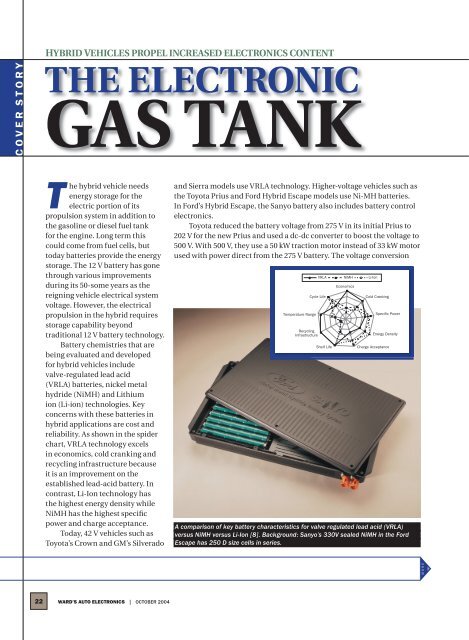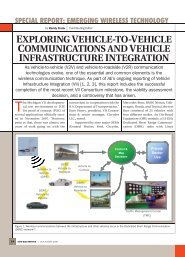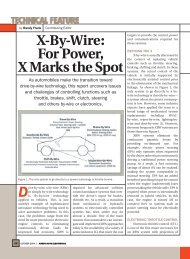here. - Auto Electronics Magazine
here. - Auto Electronics Magazine
here. - Auto Electronics Magazine
You also want an ePaper? Increase the reach of your titles
YUMPU automatically turns print PDFs into web optimized ePapers that Google loves.
C O V E R S T O R Y<br />
HYBRID VEHICLES PROPEL INCREASED ELECTRONICS CONTENT<br />
THE ELECTRONIC<br />
GAS TANK<br />
The hybrid vehicle needs<br />
energy storage for the<br />
electric portion of its<br />
propulsion system in addition to<br />
the gasoline or diesel fuel tank<br />
for the engine. Long term this<br />
could come from fuel cells, but<br />
today batteries provide the energy<br />
storage. The 12 V battery has gone<br />
through various improvements<br />
during its 50-some years as the<br />
reigning vehicle electrical system<br />
voltage. However, the electrical<br />
propulsion in the hybrid requires<br />
storage capability beyond<br />
traditional 12 V battery technology.<br />
Battery chemistries that are<br />
being evaluated and developed<br />
for hybrid vehicles include<br />
valve-regulated lead acid<br />
(VRLA) batteries, nickel metal<br />
hydride (NiMH) and Lithium<br />
ion (Li-ion) technologies. Key<br />
concerns with these batteries in<br />
hybrid applications are cost and<br />
reliability. As shown in the spider<br />
chart, VRLA technology excels<br />
in economics, cold cranking and<br />
recycling infrastructure because<br />
it is an improvement on the<br />
established lead-acid battery. In<br />
contrast, Li-Ion technology has<br />
the highest energy density while<br />
NiMH has the highest specifi c<br />
power and charge acceptance.<br />
Today, 42 V vehicles such as<br />
Toyota’s Crown and GM’s Silverado<br />
22 WARD’S AUTO ELECTRONICS | OCTOBER 2004<br />
and Sierra models use VRLA technology. Higher-voltage vehicles such as<br />
the Toyota Prius and Ford Hybrid Escape models use Ni-MH batteries.<br />
In Ford’s Hybrid Escape, the Sanyo battery also includes battery control<br />
electronics.<br />
Toyota reduced the battery voltage from 275 V in its initial Prius to<br />
202 V for the new Prius and used a dc-dc converter to boost the voltage to<br />
500 V. With 500 V, they use a 50 kW traction motor instead of 33 kW motor<br />
used with power direct from the 275 V battery. The voltage conversion<br />
A comparison of key battery characteristics for valve regulated lead acid (VRLA)<br />
versus NiMH versus Li-Ion [8]. Background: Sanyo’s 330V sealed NiMH in the Ford<br />
Escape has 250 D size cells in series.<br />
M O R E






